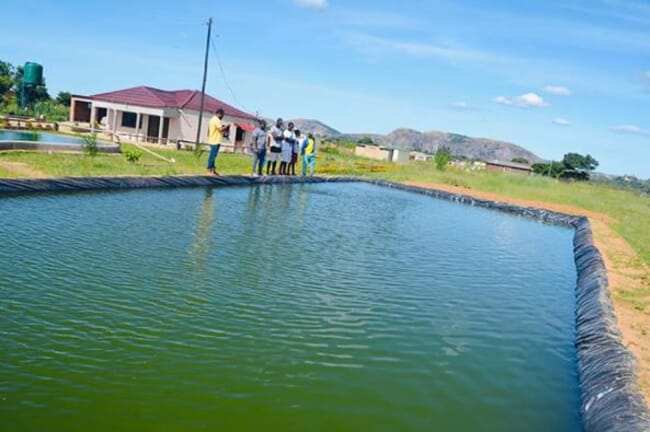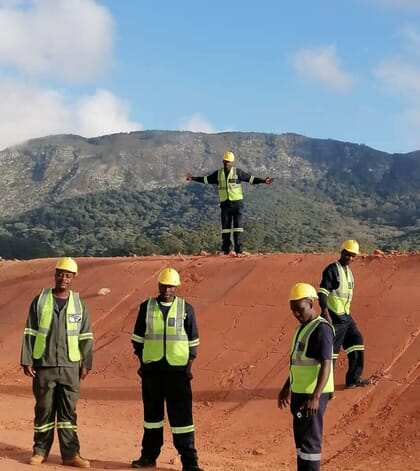
© ZAKIS
However, the building of ponds and dams and distribution of fingerlings to farmers in various parts of the country has not been complemented by sufficient market-oriented education and skills training.
As a result, said Waddilove Sansole, team leader of European Union (EU)-funded Zimbabwe Agriculture Knowledge and Innovation Services (ZAKIS), many operations are struggling to grow beyond subsistence production and access reliable markets that pay competitively.
“Production knowledge is there on many operations but what farmers need now is training for them to be able to produce what the market is looking for,” he told The Fish Site.
“Farmers have been trained but the training has been given for the sake of training without that important understanding of what the market wants. Big food chains don’t buy your fish just because you have delivered fish at their doorstep. They have certain specifications that must be met by the supplier. With the training that most of our farmers have they fail to clinch those key markets so you find that some of their fish rots at their farms and they run losses. We recognised that weakness which we want addressed by facilitating market-orientated training. We want to build strong linkages between the farmer and the market.”
ZAKIS is part of a larger EU-funded Zimbabwe Agricultural Growth Programme (ZAGP) that was launched in Zimbabwe in June 2019. The €40 million initiative seeks to boost the beef, dairy, pig, goat and poultry production, complemented by ZAKIS which is mandated to work with the Ministry of Lands, Agriculture, Water, Climate and Rural Resettlement to coordinate market-oriented education and extension services across the five value chains.
ZAKIS has a budget of €1.3 million in 2020 alone, while its overall budget covering the period from its launch in June 2018 to its end November 2022 is €6.6 million.
ZAGP says Zimbabwe's agricultural sector is held back by a reform bottleneck. Approaches to research, education, and consulting are outdated, it adds, so the programme running in all of the country’s 10 provinces intends to reach 60 percent of the rural population with “innovative agricultural education, research, and consulting.” Two “centres of agricultural excellence” at Chibero Agricultural College near Harare, the capital city, and Matopos Research Institute, 440km to the south-west, have been identified to serve as focal points for knowledge dissemination through demonstrations, workshops, field days, innovation fairs and farmer training.

To that end, ZAKIS, which is being run through a consortium of five non-governmental organisations - Welthungerhilfe Zimbabwe, Sustainable Agriculture Technology, SNV, International Crops Research Institute for the Semi-Arid Tropics (ICRISAT) and Community Technology Development Organisation - and the ministry of agriculture held a training of trainers workshop at Chibero Agricultural College. The two-day event held in late July 2020, was attended by 30 government agricultural extension workers representing four districts - Matobo, Insiza, Chegutu and Mhondoro-Ngezi - and officials at the two centres of agricultural excellence. Topics covered include fish biology and health, feed management, harvesting, record keeping, quality assurance, marketing and fish farming infrastructure.
“So the Chibero workshop was to train trainers who will use the two centres of agricultural excellence to take that education down to the fish farmer not only in the four districts but many others adjoining them,” added Sansole of Welthungerhilfe Zimbabwe but has been given an added responsibility of being the ZAKIS team leader.
“What we do as ZAKIS is to coordinate that interface between farmers and the market. That is why at the Chibero workshops we had a representative from Profeeds, a private company. All the other workshops, demonstrations, innovation fairs, field says and so on will always have the private sector on the one hand and farmers on the other with us in the middle.”
Profeeds manufactures chicken, cattle, horse, pig, goat and aquatic. In 2019 the company introduced fish husbandry training sessions.
According to official statistics, Zimbabwe’s fish output averages 18,400 tonnes every year, yet demand is estimated at 60,000 tonnes yearly.
To ramp up output, alleviate rural poverty and improve nutrition, the government has initiated a number of initiatives over the years. In May 2017, the then President, Robert Mugabe launched the Command Fisheries Programme at an event where he also commissioned the country’s largest inland dam, Tugwi-Mukosi. He witnessed the stocking of 200,000 tilapia fingerlings into the 1.8 billion cubic metre reservoir. Seven months later, his successor, Emmerson Mnangagwa launched a US$432 million project that is expected to help improve the country's livestock output, including aquaculture. A number of NGOs and corporates run their own initiatives too.
More government, NGOs and private sector initiatives, said Tatenda Rukato, of Aquaculture Distributors should be accompanied by marketing training.
“At all projects where we [Aquaculture Distributors] build ponds, provide feed and fingerlings, we make sure we offer training,” she said.
“We do that because we operate on contract basis. There is no point spending much money to build ponds, provide feed and fingerlings to a farmer who has no training on how to manage a fish farm. But because fish farming is a fairly new enterprise in the country, it is necessary that the various players focus on training, so production is market-driven.”

© Aquaculture Distributors
An academic paper, “Fish farming as an innovative strategy for promoting food security in drought risk regions of Zimbabwe”, published in the Journal of Disaster Risk Studies in 2017, says lack of market opportunities causes some aquaculture projects to fail.
“The success of any viable entrepreneurial venture rests on the availability of markets to export the produce,” it says.
“The article establishes that the lack of market opportunities and low cash injections hindered fish farming in Mwenezi district. The shortage of ready markets led to fish farmers selling fish to local neighbourhoods and businesses at a relatively low price because of unavailability of the external markets. Failure to obtain ready markets constrained fish farmers to expand into a more commercialised business; hence, they remain small at subsistence level.”
One of the participants in the study said they had little knowledge about the market.
“After harvesting fish we face challenges in terms of transport and markets to sell our produce,” she said.
“We end up selling our fish to individuals such as teachers, business owners at low prices which is discouraging since fish farming is hard work and we sometimes get little. We do not have enough knowledge about where to sell our fish as other towns are very far and we do not have enough money to hire trucks to transport the fish to other big towns.”
Indeed, ignorance of the market is one of the reasons why Wadzanai Fish Farming Cooperative that operates at Svisva Dam in Musana area, in northern Mashonaland Central Province is struggling.
“We sell to local villagers as well as civil servants at local clinics and schools,” Zacharias Mabeteya, a member of the 20-member co-operative told The Fish Site.
“They come to buy fresh fish at our ponds while we also move around selling. At some point we started selling to supermarkets in Bindura and Harare but securing reliable transport was a hustle. Remember ours is a highly perishable commodity, so any delay in reaching the market can be disastrous for the business. Also, supermarkets want to be assured that fish supply will be reliable. I think growing our market beyond our immediate surroundings was difficult. What we need is greater market access and more relevant training in that respect because we only have basic training. Learning never ends.”



